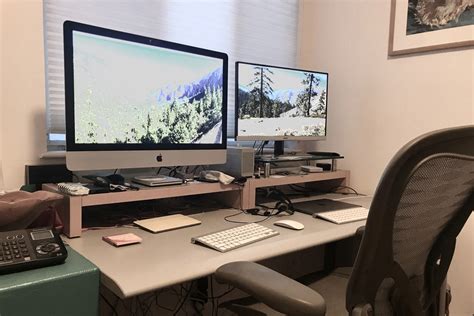Are you transitioning to remote work and need guidance on setting up a productive home office? Whether you’re a freelancer, a remote employee, or an entrepreneur, creating a comfortable and efficient workspace in your home is essential for maintaining productivity and focus. In this blog post, we’ll be providing you with valuable tips and advice on how to set up the perfect remote workstation in your home office. From choosing the right location and ergonomic furniture to establishing healthy routines and boundaries, we’ve got you covered. So, if you’re ready to transform your home into a thriving workspace, keep reading to learn how to optimize your home office for maximum productivity and comfort.
Choosing the Right Location for Your Home Office
When choosing the right location for your home office, it’s important to consider several factors to ensure a productive and comfortable work environment. One of the first things to consider is the amount of natural light available in the space. Natural light can boost productivity and mood, so try to find a location with ample windows.
Another important consideration is noise levels. Choose a location in your home that is away from high-traffic areas or noisy distractions, such as the kitchen or living room. If possible, consider setting up your home office in a room with a door that can be closed to minimize distractions.
Additionally, it’s crucial to consider the ergonomics of the space. Look for a location where you can set up your desk, chair, and other furniture in a way that promotes good posture and comfort. This could mean setting up your home office in a room with enough space to accommodate your ergonomic desk and chair.
Lastly, consider the accessibility of the location. Choose a space that is easily accessible from the rest of your home, but also provides enough privacy and separation to establish boundaries between your work and personal life.
Ergonomic Furniture and Equipment for Better Comfort
When setting up your home office, one of the most important considerations is the ergonomic furniture and equipment you will be using. It is crucial to invest in items that will provide better comfort and support for your body, as you will likely be spending long hours at your desk.
One of the key pieces of ergonomic furniture is a good quality office chair. Look for a chair that has adjustable height and lumbar support to ensure proper posture and reduce the risk of back pain. Additionally, a height-adjustable desk can also be beneficial, allowing you to alternate between sitting and standing throughout the day.
In terms of equipment, consider investing in an ergonomic keyboard and mouse to reduce strain on your wrists and hands. A monitor arm can also help to position your screen at the correct height and distance, reducing eye and neck strain. Furthermore, using a footrest can provide additional support and improve circulation.
Overall, prioritizing ergonomic furniture and equipment in your home office setup can significantly improve your comfort and well-being, leading to greater productivity and overall satisfaction in your workspace.
Organizing Your Workspace for Maximum Productivity
When it comes to maximizing your productivity in a home office, organizing your workspace is key. A cluttered and disorganized environment can lead to distractions and inefficiency, while a well-organized space can help you stay focused and on task.
First, start by decluttering your workspace. Remove any items that are not essential to your work, and find a designated place for everything. Use storage solutions such as shelves, bins, and organizers to keep your workspace tidy and free from clutter. This will not only improve your productivity but also create a more pleasant and inviting work environment.
Next, consider the layout of your workspace. Arrange your furniture and equipment in a way that promotes efficiency and ease of movement. Keep frequently used items within arm’s reach, and position your desk and chair in a way that minimizes distractions and maximizes comfort.
Lastly, create a system for managing your tasks and documents. Invest in a filing system or digital organization tools to keep track of important paperwork and projects. By maintaining an organized workspace, you can create a more productive and stress-free work environment.
Setting Up Reliable and High-speed Internet Connection
Having a reliable and high-speed internet connection is crucial for anyone working from a home office. It can significantly impact your productivity and the quality of your work. Without a stable connection, you may experience frequent disruptions, slow loading times, and other technical issues that can hinder your workflow. Therefore, it’s essential to ensure that you have a strong and reliable internet connection.
First and foremost, you need to choose the right internet service provider (ISP). Do some research and find out which ISPs are available in your area and what plans they offer. Look for providers that have a good reputation for reliability and customer service. You want to make sure that you can rely on your ISP to provide uninterrupted service and promptly address any issues that may arise.
After choosing an ISP, you need to select the right internet plan for your needs. Consider the speed, data limit, and cost of the plans offered by the ISP. If you work with large files or need to participate in video conferences, you’ll want to opt for a plan with high-speed internet. Additionally, if you have multiple devices connected to the internet at the same time, you may need a plan with a higher data limit to avoid any slowdowns or extra charges.
Once you have set up your internet connection, it’s crucial to ensure that your workspace is positioned in a location with a strong Wi-Fi signal. If necessary, consider investing in a Wi-Fi extender to enhance the coverage in your home office. You’ll want to avoid any dead spots or areas with weak signals that could disrupt your connection and create frustration.
Optimizing Lighting and Acoustic Conditions
When setting up your home office, it is important to pay attention to the lighting and acoustic conditions in the space. Poor lighting can cause eye strain and fatigue, while excessive noise can be distracting and hinder concentration. By optimizing lighting and creating acoustic conditions that foster focus and productivity, you can ensure that your home office is a conducive environment for work.
When it comes to lighting, natural light is the best option. Position your desk in a way that allows for plenty of natural light to come in without causing glare on your computer screen. If natural light is not sufficient, consider investing in good quality LED lights that mimic natural light. Additionally, using task lights for specific areas and adjustable lighting to control brightness can help in creating a well-lit work environment.
As for acoustic conditions, reducing noise is vital to maintaining concentration. This can be achieved by using noise-cancelling headphones, soundproofing the room, or simply choosing a quiet area of your home for your office space. Additionally, adding soft furnishings such as rugs, curtains, and acoustic panels can help in absorbing sound and reducing echo in the room.
By paying attention to the lighting and acoustic conditions in your home office, you can create a workspace that is not only comfortable but also conducive to productivity and focus.
Creating a Distraction-Free Environment
When working from home, one of the biggest challenges is staying focused and free from distractions. Creating a distraction-free environment is essential for maintaining productivity and achieving work-life balance. One of the first steps to achieving this is to designate a dedicated workspace, separate from the rest of your living space. This can be a room or just a specific area in a room where you can work without interruptions.
Another important aspect of creating a distraction-free environment is to minimize visual and auditory disturbances. This can be achieved by organizing your space in a way that minimizes clutter and noise. Keep your workspace clean and organized, and consider using noise-cancelling headphones or background music to block out any distracting sounds.
It’s also important to set boundaries with your family members or housemates to avoid interruptions during your work hours. Clearly communicate your work schedule and when you need to focus, so that others are aware of when you shouldn’t be disturbed. Additionally, establishing a daily routine and sticking to it can help create a predictable environment that minimizes distractions.
Lastly, consider implementing digital tools and techniques to block out online distractions. There are numerous apps and browser extensions available that can help you stay focused by limiting your access to social media, news websites, and other time-wasting platforms. By incorporating these tools into your work routine, you can create a digital environment that supports your productivity.
Establishing Healthy Routines and Boundaries
When working from a home office, it can be challenging to maintain a healthy work-life balance. Establishing healthy routines and boundaries is essential to avoid burnout and maintain productivity. One way to do this is by setting specific work hours and sticking to them, just as you would in a traditional office setting. This helps create a sense of routine and structure to your day, allowing for dedicated work time as well as time for personal activities.
It’s also important to set boundaries with both work and personal life. Communicate your work hours and availability to your colleagues, clients, and family members so that they understand when you are and are not available. This can help prevent interruptions during work hours and ensure that you have time to focus on your tasks without distractions.
Additionally, establishing healthy boundaries includes taking regular breaks throughout the day to rest and recharge. This might involve scheduling short breaks to stretch, grab a healthy snack, or simply step away from your workspace. Setting boundaries with technology is also important, such as disconnecting from work emails and messages after a certain time in the evening to allow for relaxation and quality time with family and friends.
By prioritizing healthy routines and boundaries, you can create a work environment that supports your well-being and overall productivity, leading to a more balanced and fulfilling work-from-home experience.





